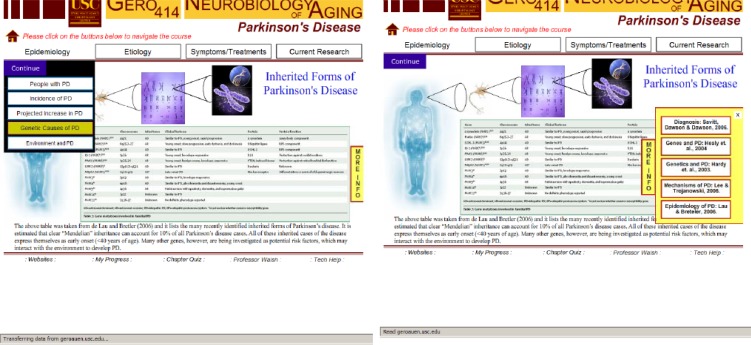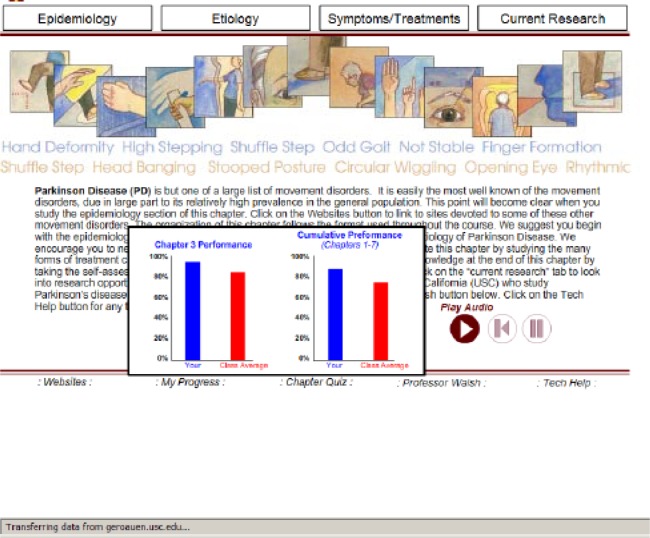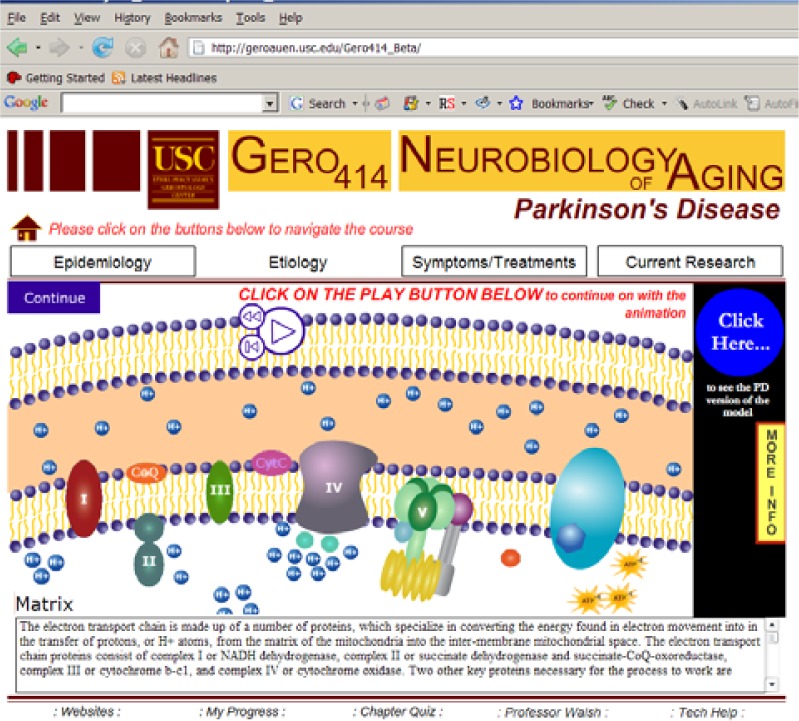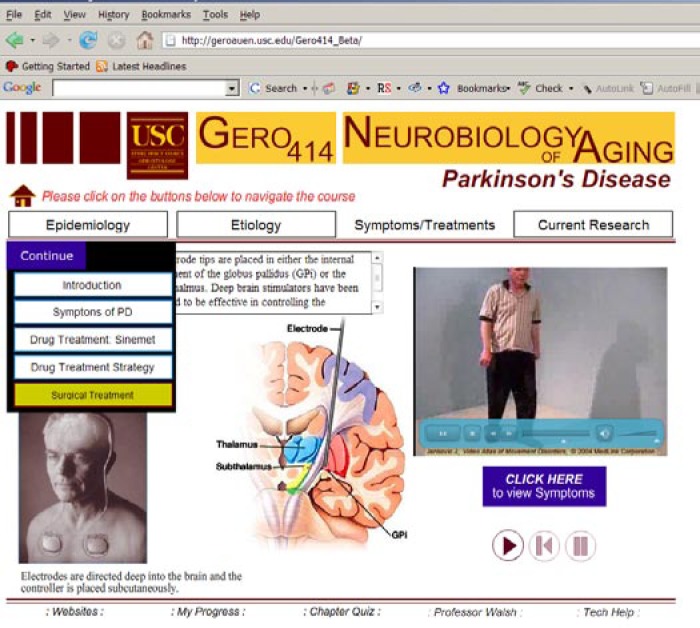Abstract
We developed an online multimedia tool designed to enhance the student-learning environment in neurosciences through multi-sensory engagement. The combined use of scrolling text, narrations, and visual imagery engages multiple sensory modalities for effective learning, and it assists students in visualizing complex processes in the nervous system. The initial rollout of the online tool is for instruction in Parkinson’s disease (PD), but its structure is flexible and can be used for teaching a variety of subjects. The instructor can access the tool online during lecture, and students can access the same information via the internet outside of class. In addition, each chapter is stand-alone and thus can be accessed online by other faculty or students to supplement other courses. Within each chapter or module, information is presented in outline format with greater detail accessible via sequential drop-down menus. This layering of related topics creates a spatial and motor-accessed path for learning. These multiple forms of engagement offer rich information representations to improve students’ knowledge encoding, storing, and retrieval via multiple pathways. For instance, the tool includes student-controlled 2-D and 3-D animations, and video clip demonstrations of both patient case studies and on-campus research projects directly related to the subject material. Supplemental readings consist of current research articles (in Adobe Acrobat PDF file format) accessed within each educational topic. The teaching tool for PD is online at http://geroauen.usc.edu/Gero414_Beta/.
Keywords: student-centered learning, dynamic course delivery, science education, media-enhanced instruction, neuroscience, Adobe Flash, PD
Neuroscience is a unique field within the life sciences. Perhaps because the brain and nervous system are so complex, neuroscience has developed as an interdisciplinary field that incorporates a broad range of disciplines, including biology, psychology, chemistry, physics, gerontology, computer sciences, and engineering. The field is relatively new and is rapidly changing as interest in the brain increases. This rapid growth presents several challenges. As more and more colleges and universities seek to develop neuroscience courses and majors, there is a need for state-of-the-art course materials that can be used for undergraduate teaching. In addition, the very interdisciplinary nature of the field can present problems for students, who must be familiar with many disciplines and must understand the interconnectedness among many areas of study. A report from the National Research Council, Bio 2010 (2003), referred to an “interdisciplinary gap” in that students often see the courses they take as discrete packages with few interconnections.
A significant challenge to educators in a field as diverse as neuroscience is to demonstrate how findings from molecular biology, physiology, biochemistry and engineering complement each other to further knowledge in the basic science understanding of how the brain works (Gershon, 2001). More importantly, it is essential that students understand how knowledge is gained in each of these disciplines through research. Ultimately, students are asked to blend knowledge from these many disciplines to gain a more complete understanding of the brain. This challenge is compounded at many universities by the diverse backgrounds of students studying neuroscience, and is best met by linking students’ prior knowledge and interest to the material to be presented. Thus, effective instruction will reflect a marriage of the specific course objectives with the diverse characteristics of the learners (Cleland, 2002). Moreover, instructors need to link their course content to the varied career trajectories that radiate from the field of neuroscience to help guide students into professional tracks. Federal and private foundation programs share a common goal of wanting to recruit the best minds into science research careers with a goal of translating scientific progress into solutions for society’s most pressing issues. Examples of such programs include the NSF DUE-CCLI and Interdisciplinary Training for Undergraduates in Biological and Mathematical Sciences (UBM) programs, Science Education Partnership Awards (SEPA) sponsored by the National Institutes of Health (NIH), and the Howard Hughes Medical Institute (HHMI) Undergraduate Science Education Programs.
Members of the Society of Neuroscience recognized the challenges in undergraduate neuroscience education when they established the Faculty for Undergraduate Neuroscience group (FUN; www.funfaculty.org) in 1991. FUN was established to support innovation and excellence to undergraduate neuroscience education and research (Ramirez and Normansell, 2003) (www.pkal.org/documents/FacultyUndergradNeuroscience.cfm). Recognizing a need for a method to communicate information about undergraduate teaching innovations to a diverse community of neuroscientists, FUN established a peer-reviewed journal in 2002. The Journal of Neuroscience Education (JUNE; www.funjournal.org) is intended to provide a forum for the dissemination and discussion of a variety of innovations and best practices in undergraduate neuroscience education. Along with CBE-Life Sciences Edition (CBE-LSE), JUNE provides a valuable resource for improving undergraduate education in this area.
Educational research tells us that it is important to recognize that students enter learning contexts with prior knowledge, misconceptions, and varied levels of interest in the subject matter (Ainley, Hidi, and Berndorff, 2002; Nussbaum and Sinatra, 2003). Responding effectively to the range of student strengths and needs demands flexible and innovative teaching strategies. Students of biological sciences must master a large, academically demanding foreign vocabulary, and apply this vocabulary to complex and abstract biological constructs (e.g., how the cell works, what processes take place in its nucleus, how cells interact to create a functioning system, etc.). Students in life sciences must also be adept at transferring their vocabulary knowledge to dynamic 3-dimensional constructs. Students must be able to describe how a cell is assembled in 3-D space, and must be able to articulate from a mechanistic perspective what purpose the cell and its parent organ has in the physiology of the human body.
Our response to this challenge was to implement a multimedia-learning environment that facilitates learning in the neurosciences by using technologies commonly employed for communication via the Internet. The teaching tool described in this paper uses a strategy of interactive and student-centered lecture delivery, which maximizes learning by presenting content in multiple media formats, drawing students’ attention to salient features of the visual supports, and making real-world connections that foster transfer of knowledge as well as the development of persistent STEM interest (Bransford, Brown, and Cocking, 2000). The tool employs both text and narration as well as a variety of visual imagery (2-D images and 2-D and 3-D animation) that create spatial and dynamic mapping of course information. In addition, short 2–3 minute case study video-clips are embedded in the tool to help students make connections to clinical applications. Providing students with several alternative methods of accessing material enhances understanding, and helps maintain interest in challenging material. Simulation and visualization tools are essential to helping students understand dynamic models. The use of these methods improves success for all types of learners, but it especially benefits at-risk students failed by traditional teaching methods (Dede, 2000). Other research in applied technologies indicates that optimal design of course materials includes a clear narrative description integrated with visual models (Clark, 2004a). This design is reinforced in our neuroscience teaching tool by the professor’s integration of the online education tool in class, instead of PowerPoint presentations, and by the ability of students to access narrative descriptions online while studying on their own time.
MATERIALS AND METHODS
The online education tools format was developed with a dynamic construction, which utilizes a single flexible template that generates the course by placing assets (e.g., text, images, buttons, audio, videos, communication components, 3-D interactive animations) on the screen as student navigates the content. Asset placement, size, and other appearance information are stored on a database, which is called by the template depending on a student’s navigational activity. To decrease production costs and to allow for access on all computer operating systems, the course uses off-the-shelf developmental software programs, which are found within Adobe’s Creative Suite (currently in its 3rd version). Adobe Photoshop™ and Illustrator™ are utilized for 2-D image production, Adobe Premiere™ and Adobe AfterEffects™ for posting and editing film clips and Adobe Flash™ and ColdFusion™ were used to develop highly interactive assets, the template, and database functionality. Three-dimensional modeling files developed in 3-D software (i.e. AutoDesk 3D Max™, Maya™, etc.) were placed into the interactive Adobe Flash™ framework to allow for student interactivity through creatively using their flash video (flv) compressed video segments. Dynamic course design was developed by using the database management software ColdFusion™ to transfer all necessary information from a SQL database to the course’s Flash template. Because the online learning tool uses commonly available software like the products indicated above, it is accessible from most computers connected to the Internet.
RESULTS
The online module for Parkinson’s disease was organized into an outline format that provides a clear road map of the subject area. In this module, students can navigate the four major sub-categories of Epidemiology, Etiology, Symptoms/Treatments and Current Research. Pull-down menus descend from each of these categories to reveal the next tier of related subjects (Fig. 1). Clicking each one of these tabs leads the student into sites containing the learning information including text, narration, and imagery. Students self-navigate through the course at their own pace, via the benefits of implicit or procedural learning tied to the course’s organization (i.e. navigating the map of how information is structured), and they engage the sensorimotor system activated during hand and arm movements required for navigation. Thus, navigating the online tool collectively and simultaneously activates many brain areas to form a stronger memory and more complete understanding of the material.
Figure 1.
Illustration of pull-down menus for topics of study within the major categories of Parkinson’s disease and access to outside readings. The images illustrate the outline format of the course, with four major category tabs of Epidemiology, Etiology, Symptoms/Treatments and Current Research. Clicking on the tab highlights it in gold color. Clicking on the blue continue button to the left triggers a drop-down menu of topics within the major category. The topic illustrated is Genetic causes of PD (highlighted in green). Students interested in reading more about the topic are directed to the yellow MORE INFO tab. Clicking on MORE INFO triggers a drop-down menu of Adobe Acrobat TM pdf files of original research articles.
Supplementary reading material was provided directly online as Adobe Acrobat™ pdf files of original research articles. Students accessed the original articles by clicking on the MORE INFO tab found in each learning exercise (Fig. 1). This method of providing supplementary readings eliminated the need for designating an assigned textbook. Using original research articles instead of a textbook also allowed us to design the course around current interests instead of the table of contents found in a text. Lastly, use of original research articles allowed the instructor to rapidly update with articles at any time during the semester of instruction. Narration is triggered automatically by entering a new learning module or in some cases by clicking on the play audio button (Fig. 2).
Figure 2.
Screen capture illustrating play audio option and viewing course progress on chapter quizzes. Pressing the play audio button turns on narration. Pressing the “My progress” button triggers a pop up of your score on the quiz and how it ranks against the rest of the class.
Two-dimensional animations were used in the online Parkinson’s disease teaching tool to facilitate learning in the particularly difficult instruction on links between pathology in the electron transport chain and Parkinson’s disease and links between a disruption in calcium homeostasis and Parkinson’s disease in the etiology section of the course (Fig. 3). Videos of case studies taken from Jancovic (2004) of actual patients suffering from Parkinson’s disease with associated before and after treatment effects were included in the Symptoms/Treatments category. These real case studies were used to provide an accurate view of the disease and to enhance learning in the undergraduate population (Fig. 4).
Figure 3.
Screen capture illustrating 2-D animation of the electron transport chain and how it is impacted in PD. Clicking on the play button takes the student through a step-by-step animation of the electron transport chain.
Figure 4.
Screen capture illustrating the use of video of case studies for patients suffering from PD. Entering the “Surgical Treatment” subcategory automatically brings an explanation of deep brain stimulation methods of treatments. Clicking on the “CLICK HERE to view symptoms” shows the Parkinson’s disease state. The next option is to “CLICK HERE to view treatment” to view the impact of deep brain stimulation.
As students navigate through the course, they are instructed to click on the “chapter quiz” tab found on the bottom of all pages and to take the quiz. Clicking on the submit quiz results in its automatic grading and immediate feedback on which questions were answered incorrectly. Subsequent clicking on the incorrect answers sends the student back to the section of the course where the correct answer to the question can be found for further constructive learning.
Students are then encouraged to click on the “My Progress” tab at the bottom of the each page to find out how their performance ranked with the rest of the class. This later tab is also designed to generate a cumulative summary of the students’ progress up to that point in the course (Fig 2).
The final component of the course is found under the “Current Research” category found at the top of each page. Clicking on this tab reveals a draw-down menu of researchers at our institution presently performing research related to PD. This later feature was included to provide undergraduates with a link between basic science facts, the research that contributed to this knowledge and how research is moving clinical practice forward. This option also provides undergraduates with an excellent venue for investigating laboratories they might consider participating in under the undergraduate directed research program.
Two pilots were conducted to assess the effectiveness of the course for student knowledge gains, and to capture student perceptions of the tool. The first set of data was obtained via www.surveymonkey.com from a class of thirty students taking the Neurobiology of Aging course for which the Parkinson’s disease module was designed. Results are presented in Table 1.
Table 1.
Student evaluations of the online learning tool
| ITEM | Response | % |
|---|---|---|
| Problems accessing tool | No problems | 100% |
| Course loads in timely manner | Very fast | 78.6% |
| Connection type | T1 or DSL | 93% |
| Navigation intuitive | Very intuitive | 73.3% |
| Narrations helpful | Very helpful | 25% |
| External website links helpful | Very helpful | 56% |
| Additional information helpful | Very helpful | 37.5% |
| Animations helpful | Very helpful | 87.5% |
The PD module was also used in a behavioral neuroscience course taught by Dr. Gary Dunbar at Central Michigan University. Students in this course were randomly assigned to one of two conditions for content delivery supplemental to course lectures: the online tool, or PowerPoint accessed via Blackboard. At the end of the semester, students completed a survey of presentation quality using a 5-point Likert-type scale (5=excellent); a knowledge assessment was also administered to both groups (see Table 2). We hypothesized that students assigned to the online tool would rate the presentation of material more highly and perform better on a knowledge assessment than students assigned to PowerPoint.
Table 2.
Quality and knowledge assessment results (1n=32; 2n=22).
| ITEM | PowerPoint1 Mean (sd) | Online tool2 Mean (sd) | p |
|---|---|---|---|
| Quality | 3.09 (.78) | 3.91 (.75) | .000 |
| Learn | 2.56 (1.01) | 3.45 (1.01) | .001 |
| Easy | 2.78 (1.26) | 3.77 (1.07) | .002 |
| Replace | 2.34 (1.15) | 3.45 (1.10) | .000 |
| Enjoy | 2.06 (1.11) | 3.27 (1.35) | .000 |
| Assessment | 4.34 (1.29) | 4.88 (1.57) | .085 |
Significant results were observed for all five quality items. Students assigned to the online tool gave significantly higher ratings on overall quality of presentation, amount of material learned, ease of comprehending the material, extent to which the material would be useful in replacing a missed lecture, and the degree to which they enjoyed using this mode of presentation. In addition, the knowledge assessment revealed marginally significant results, with a trend for students in the online tool condition scoring higher than those assigned to PowerPoint. This finding is particularly promising given the lack of power given the relatively small sample (Cohen, 1992), and the limitations faced in creating an assessment that included only material presented in both delivery formats.
DISCUSSION
We developed an online multimedia-teaching tool for education in diseases affecting the aged brain. The tool blends basic science research in the complementary fields of epidemiology, biochemistry, physiology and engineering with clinical practice in the diagnosis and treatment of disease. The first module covered Parkinson’s disease, and students uniformly praised the new method of course material delivery. The students were able to compare the online teaching tool in PD with the use of traditional PowerPoint presentations for other diseases like Alzheimer’s disease and Amyotrophic Lateral Sclerosis. Students found the after-hours access to lecture material via the Internet to be useful for their studying. Many students commented that they liked the ability to obtain actual scientific reading materials via the “more info” library of Adobe Acrobat™ pdf files versus using traditional text.
The online educational tool we are developing for teaching neuroscience incorporates a number of instructional elements indicated in prior research to lead to strong student outcomes, both cognitive and affective (Bransford, Brown, & Cocking, 2000). Our survey revealed a significant percentage of our students viewed the narration or audio part of the course to be very helpful. The interactive nature of navigating the online learning tool also created a gaming-like strategy of clicking to seek information, which we believe helped to engage students interested in pursuing deeper learning (Sandford and Williamson, 2005) (www.futurelab.org.uk/research/handbooks/03_01.htm). A National Science Foundation (NSF) research project entitled “Guided Interactive Virtual Environments for Case-Based Learning” found that to ensure proper scaffolding, four concepts must be present in the gaming component including: interactivity, reflection, feedback, and guidance (Moreno and Mayer, 2005). Our online education tool grew from personal experience, learning theory, and the need for professors to modernize their course delivery to create learning environments that match the multimedia systems students’ use outside of class. In total, the new course design we developed is a hybrid between traditional college-level course delivery and technology-enhanced learning.
One of the best avenues for increasing undergraduate interest in basic science research is the use of up-to-date, innovative teaching methods. One important factor is the ability to rapidly import research-based studies into the classroom, in contrast to the use of traditional textbooks in which the research becomes quickly out of date (Ares, 2004). The design of the online learning tool easily incorporates recent research publications through its easy access to research reports in Adobe Acrobat™ file format in the “more info” library found in each learning exercise. The tool further enhances student understanding of the connection between course content and science research through the use of faculty biographies and short videos explaining ongoing research projects under the “current research” tab presented at the top of each page.
Many studies, including the National Research Council’s Bio2010 report, recommend that undergraduate biology preparation become more interdisciplinary. Modern biology research requires training in a breadth of skills that go beyond experiences that undergraduate biologists are exposed to in traditional biology courses (Gross, 2004). One possible solution to this problem is to aid undergraduates past barriers to interdisciplinary research by offering research exposure early in their education.
The online educational tool we developed helped to reduce this barrier by providing students with direct access to a text-based description of a variety of laboratories, a short video presentation of the research by the professor, and linked Acrobat files of recent research reports coming from the laboratory. The students consequently have a stronger understanding of the impact science research has on their education, since each course module will showcase the faculty research related to topics covered that week. The online portability of the teaching tool also means that other professors will be able to access the tool to supplement their courses. The tool is also available for use by academic advisors throughout the campus.
It is important to assess the impact new methods of education delivery have on learning. The design of the online learning tool allows students to assess their learning upon completing the chapter by clicking on the chapter quiz tab. This stroke opens a multiple choice quiz specific to the chapter. The online tool then automatically provide the student with a list of missed questions and clicking on the missed questions sends the student to the site within the chapter where the correct answer can be found providing a summative assessment of student learning. This form of Just In Time (JIT) information assessment of learning has been found to be effective in advancing learning (Clark, 2004b). Students are also advised to click on the “my progress” tab after taking the exam to access statistics on how their performance on the exam ranks with the rest of the class for the chapter exam. As the course develops, they will see how their cumulative performance ranks with the rest of the class as the semester progresses. The purpose of the “my progress” site is to motivate students to keep up with their peers. Students that tend to procrastinate have been found less effective at applying what they have learned to a real world setting (Clark, 2004b). This online tool is also designed for the professor to monitor student progress in completion of the weekly chapter quizzes. This information can be used to identify which students are “at risk” before they are tested for long-term retention of the material through traditional in class midterm and final examinations, and to provide appropriate support for those students.
Footnotes
This work was supported by grants from University of Southern California’s Center for Excellence in Teaching and the Office of the Provost.
REFERENCES
- Ainley M, Hidi S, Berndorff D. Interest, learning, and the psychological processes that mediate their relationship. J Educ Psychol. 2002;94:545–561. [Google Scholar]
- Ares M., Jr Interdisciplinary research and the undergraduate biology student. Nat Struct Mol Biol. 2004;11:1170–1172. doi: 10.1038/nsmb1204-1170. [DOI] [PubMed] [Google Scholar]
- Bransford JD, Brown AL, Cocking RR, editors. How people learn: Brain, mind, experience, and school. Washington, DC: National Research Council; 2000. [Google Scholar]
- Clark RE. What works in distance learning: Motivation strategies. In: O’Neil H, editor. What works in distance learning: Guidelines. Greenwich, CT: Information Age Publishers; 2005a. pp. 89–110. [Google Scholar]
- Clark RE. What works in distance learning: Instructional strategies. In: O’Neil H, editor. What works in distance learning: Guidelines. Greenwich, CT: Information Age Publishers; 2005b. pp. 25–40. [Google Scholar]
- Cleland CL. Integrating recent advances in neuroscience into undergraduate neuroscience and physiology courses. Adv Physiol Educ. 2002;26:271–277. doi: 10.1152/advan.00044.2002. [DOI] [PubMed] [Google Scholar]
- Cohen J. A power primer. Psychol Bull. 1992;112:155–159. doi: 10.1037//0033-2909.112.1.155. [DOI] [PubMed] [Google Scholar]
- Dede C. Emerging Influences of Information Technology on School Curriculum. J Curriculum Stud. 2000;32:281–303. [Google Scholar]
- Gershon D. All systems go for neuroscience. Nature. 2001;414:4–5. doi: 10.1038/35102743. [DOI] [PubMed] [Google Scholar]
- Gross LJ. Interdisciplinarity and the undergraduate biology curriculum: Finding a balance. Cell Biol Educ. 2004;3:85–87. doi: 10.1187/cbe.04-03-0040. [DOI] [PMC free article] [PubMed] [Google Scholar]
- Jancovic J. Video atlas of movement disorders. Medlink Corporation 2004 [Google Scholar]
- Moreno R, Mayer RE. Role of guidance, reflection, and interactivity in an agent-based multimedia game. J Educ Psychol. 2005;97:117–128. [Google Scholar]
- National Research Council . BIO2010: Transforming undergraduate education for future research biologists. National Academies Press; Washington, DC: 2003. www.nap.edu/books/0309085357/html/. [PubMed] [Google Scholar]
- Nussbaum EM, Sinatra GM. Argument and conceptual engagement. Contemp Educ Psychol. 2003;28:384–395. [Google Scholar]
- Ramirez JJ, Normansell L. A Decade of FUN: The first ten years of the faculty for undergraduate neuroscience. 2003. available at www.pkal.org/documents/FacultyUndergradNeuroscience.cfm. [PMC free article] [PubMed]
- Sandford R, Williamson B. Games and learning. Bristol, UK: Futurelab; 2005. www.futurelab.org.uk/research/handbooks/03_01.htm. [Google Scholar]






